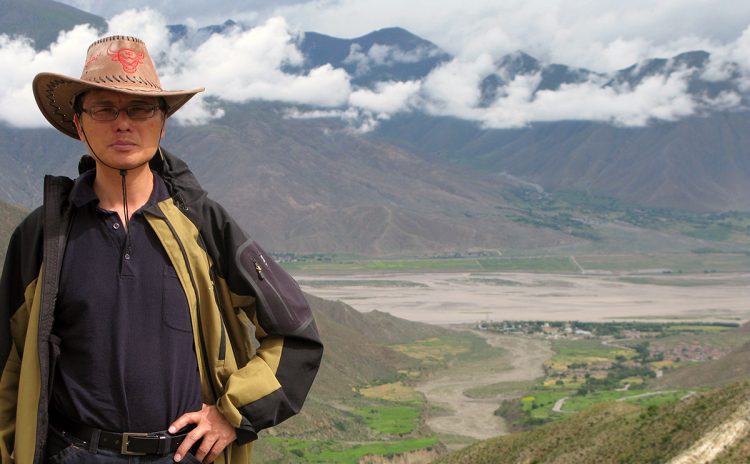More grasslands in Tibet could bring climate improvements

Professor Deliang Chen in Tibet.
In the Arctic, warming increases like a spiral. Global warming means that the periods of growth are becoming longer and vegetation growth is increasing. At the same time, heat transfer to the Arctic from lower latitudes is rising, reducing sea ice there, and this in turn is contributing towards a faster local rise in temperature.
A new research study published in the highly respected research journal PNAS shows that the situation is the reverse on the Tibetan Plateau.
Vegetation on the Tibetan Plateau has also increased as a result of global warming. However, in contrast to the Arctic areas, the longer periods of growth and the increased vegetation activity here appear to mean that global warming is being weakened.
“The reason for this is that increased evapotranspiration from plants is cooling the air,” explains Deliang Chen, Professor of Physical Meteorology at the University of Gothenburg.
The climate models also simulate daytime cooling as a result of the increased vegetation, albeit with a smaller magnitude than currently observed.
“Our results suggest that actions to restore native grasslands in degraded areas, roughly one-third of the plateau, will both facilitate a sustainable ecological development in this region and bring local and global climate benefits.”
More accurate simulations of the biophysical coupling between the land surface and the atmosphere are needed to help fully understand regional climate change over the Tibetan Plateau.
Link to article: http://www.pnas.org/content/112/30/9299.abstract
For more information, please contact:
Deliang Chen, August Röhss Professor at the Department of Earth Sciences
Tel.: +46 (0)31 786 4813, e-mail: deliang@gvc.gu.se, http://rcg.gvc.gu.se/dc
http://science.gu.se/english/News/News_detail/?languageId=100001&contentId=1…
Media Contact
All latest news from the category: Ecology, The Environment and Conservation
This complex theme deals primarily with interactions between organisms and the environmental factors that impact them, but to a greater extent between individual inanimate environmental factors.
innovations-report offers informative reports and articles on topics such as climate protection, landscape conservation, ecological systems, wildlife and nature parks and ecosystem efficiency and balance.
Newest articles

High-energy-density aqueous battery based on halogen multi-electron transfer
Traditional non-aqueous lithium-ion batteries have a high energy density, but their safety is compromised due to the flammable organic electrolytes they utilize. Aqueous batteries use water as the solvent for…

First-ever combined heart pump and pig kidney transplant
…gives new hope to patient with terminal illness. Surgeons at NYU Langone Health performed the first-ever combined mechanical heart pump and gene-edited pig kidney transplant surgery in a 54-year-old woman…

Biophysics: Testing how well biomarkers work
LMU researchers have developed a method to determine how reliably target proteins can be labeled using super-resolution fluorescence microscopy. Modern microscopy techniques make it possible to examine the inner workings…





















